简奥斯汀&现实主义
简奥斯汀

百度,输入诺觉桑寺,找到读书的网络作家简介:简·奥斯丁,(1775—1817)英国女作家,18世纪末19世纪初英国杰出的现实主义大师,被誉为“道德教育家”。
出生于英格兰汉普郡的斯蒂文顿村,父亲是教区的主管牧师。
在父兄的熏陶下,奥斯丁从小就阅读了大量的文学作品。
她16岁时开始写作,是第一个通过描绘日常生活中的普通人,使小说具有鲜明现代性质的小说家。
奥斯丁一生中共创作了6部长篇小说《理智与情感为(1811)、《傲慢与偏见》(1813)、《曼斯菲尔德庄园》(1814)、《爱玛》(1815)、(诺桑觉修道院》和《劝服》(后两部出版于她去世后的1818年)小说内容多是刻画当时英国乡村的风俗民情、社交和男女恋情等。
她的创作开启了19世纪30年代的现实主义小说高潮,在英国小说的发展史上具有承上启下的意义。
作品目录·《傲慢与偏见》《傲慢与偏见》是奥斯丁的代表作。
这部作品以日常生活为素材,一反当时社会上流行的感伤小说的内容和矫揉造作的写作方法,生动地反映了18世纪末到19世纪初处于保守和闭塞状态下的英国乡镇生活和世态人情。
这部社会风情画式的小说不仅在当时吸引着广大的读者,时至今日,仍给读者以独特的艺术享受。
·《理智与情感》简·奥斯丁在她诞生地汉普郡的斯蒂文顿繁荣而稳定的乡间长大,十二三岁就开始写作。
她早期的习作都是中短篇,光是十五六岁时写的,后人就编成了两部集子。
一七九七年,简二十二岁,完成第一部长篇小说《第一面印象》。
接着开始写《埃莉诺与玛丽安》。
这两本都是书信体小说,十多年后,分别改写成用第三人称叙述的长篇小说《傲慢与偏见》和《理智与情感》。
后者于1811年出版,等到前者于两年后问世时,后者于同年再版。
所以,尽管《傲慢与偏见》的原始本子写作在前,她第一部出版的作品却是《理智与情感》。
·《爱玛》发表于1818年,英国女作家,奥斯丁小说。
女主人公爱玛是一个“从来不在外面住宿的天下少有的女人”,孤零零的,但是充满了感情与思想,她经过一系列误会后,与男主人公先生终成佳偶。
简奥斯汀

Pride and prejudice
主演:凯拉 奈特丽 马修·麦克法登 奈特丽、 主演:凯拉·奈特丽、马修 麦克法登
导演: 导演:李安
凯特·温斯莱特 Kate Winslet .....Marianne Dashwood 艾伦·里克曼 Alan Sidney Patrick Rickman....Colonel Brandon 艾玛·汤普森 Emma Thompson .....Elinor Dashwood 詹姆斯·弗雷特 James Fleet .....John Dashwood 汤姆·威尔金森 Tom Wilkinson .....Mr. Dashwood 休·格兰特 Hugh Grant .....Edward Ferrars
奥 斯 汀
·
你 简 的 想 法 。 》 将 彻 底 改 变 汀 奥 斯 —— —— —— ——
年 时 光 , 那 么 《 成 为 的 晚 她 过 度 衣 毛 着 织 边
一 汀 是 一 个 古 板 的 老 处 女 ,
斯 如 果 你 还 以 为 简 奥 演 。 —— 《 帝 国 杂 志 》 表
湛 自 于 片 中 一 流 演 员 的 精
导演:Iain B. MacDonald 导演 主演: 主演 Julia Joyce .. Douglas Hodge ....Sir Thomas Bertram
爱 玛
Emma
主人公爱玛是个美丽、聪慧而富有的姑娘,同时也是一位不折不扣的幻想家。 她热心关注身边的浪漫故事,却又固执地认为自己永远不会陷入其中。她自作主张 为孤女哈丽埃特导演了一次又一次的恋爱。当哈丽埃特误以为自己爱上了地方官奈 特利先生时,爱玛才惊觉原来自己也在爱着奈特利先生。这虽与她一开始就宣布的 终身不嫁的誓言有悖,但坠入情网的她不得不放弃自己天真的誓言。
简 奥斯汀

参考文献:
[1][3][4]王科一译.傲慢与偏见[M].上海译文出版社出版,1985.190,143,42.
[2]鲁迅.关于女人[M].南腔北调集,第86页.
[5]马克思恩格斯选(第4卷)[M].人民出版社,1972.66.
[6]]转引自伊扬·瓦特编.奥斯丁:批评文选[M].1963年美国版,第11页.
那么,奥斯丁真正的、具体的婚姻观指的是什么呢?根据上述的分析,我们可以明确的知道,奥斯丁的婚姻观与当时流行的观念并不一致,她认为:男女双方的真挚感情是理想婚姻的基础,并且双方必须是门当户对的。其中的门当户对又要如何理解呢?首先,在物质方面也就是财产或金钱方面,男女双方不能相差太远,简单的说,就是富翁不能与乞丐匹配婚姻。这一点在奥斯丁的作品中描写的很明确:地主小姐爱玛能与年轻的地主老爷奈特利先生结婚,而没有财产的哈利特只能嫁于农民。其次,从精神方面来说,缔结婚姻的双方要有相当的教育背景。就象在《傲慢与偏见》中那拥有理想婚姻的一对——达西与伊丽莎白,他们都接受过一定的教育,并通过自身的修养与生活的磨练得以提高,因而他们有共同的话题、相当的兴趣,所以他们能和谐的生活在一起
[7]贾文渊译.爱玛[M].青海人民出版社, 第10章.
因此,从作品中我们也可以看到,奥斯丁一再强调正当的婚姻关系应当是双方互相了解,互相尊重,并且要注重感情。而在她的小说《曼斯菲尔德庄园》中的伯特拉姆夫人事实上就是对潘宁顿女士的理想妻子形象的讽刺漫画:她丝毫没有主见,在任何情况和场合都要向托马斯爵士请示,甚至就连她是否没有基尼也能度过一个傍晚这样的事,她也要向他请教。她在家庭生活中拒绝承担任何责任的后果,是托马斯爵士不得不承担的一个吃不消的重担。这也从一个侧面表现了当时流行的观念,可见和奥斯丁的观念是不一致的。因此,在赋予她的女主人公们以成功的同时,奥斯丁提供她们的理想婚姻是现实的而非海市蜃楼式的,因为它不仅包含了外貌的吸引,更有双方互相的理解、尊重、平等和自由。而正是这些品质,使人有可能超越家长制的束缚,实现自我。那么,奥斯丁心目中的理想婚姻又是什么样的呢?我们可以从《劝导》中对克罗夫特夫妇共驾一辆马车的描述中找到答案:“但是她冷静地往旁边一拽缰绳,车子便侥幸地脱险了。后来还有一次,多亏她急中生智地一伸手,车子既没翻到沟里,也没撞上粪车。安妮看到他们的赶车方式,不禁觉得有几分开心,她设想这一定很能反映他们是如何处理日常事务的。”奥斯丁在此所要暗示的是,克罗夫特夫妇之所以能在婚姻生活中保持稳定,是因为跟赶车时一样,克罗夫特太太并不是盲目的顺从丈夫,而是设法改正他的错误,激发其斗志。他们夫妻之间不是依赖和被依赖、统治和被统治的主从关系,而是平等互助、共同参与的伴侣关系。
简奥斯汀的作品

Mansfield Park
《曼斯菲尔德庄园》以男女青 年的恋爱婚姻为题材。情节更 为复杂,突发性事件更集中,社 会讽刺意味也更加浓重。小说 最后以范妮和埃德蒙的美满姻 缘为结局,但在故事发展的过程 中,作者的讽刺笔锋主要指向 了以富足人家为代表的英国上 流社会,揭示了他们的矫揉造 作和荒唐可笑。
Master Works
创作过程
• 奥斯汀创作的小说,几乎都是长时 间的反复修订改写。她出版的第一 部小说是《理智与情感》(1811) • 《傲慢与偏见》(1813)是她的第 二部作品。这两部作品,加上她去 世后出版的《诺桑觉寺》(1818) ,都写于十八世纪的九十年代,通 常算是她的早期作品. • 《曼斯菲尔德庄园》(1814)、《 爱玛》(1816)与《劝导》(1818 )则写于十九世纪,算是后期作品 。这六部作品,总共不过一百五十 万字(中文),数量不算多。作品 初出版时,销量也不算很大
Sense and Sensibility
• 女主人公根据表面现象 产生合情合理的推测和 判断,细心的读者虽然 不时产生种种疑惑,但 思绪会自然而然随着好 的观察而发展,等着最 后结果出现时,与表面 现象截然不同,造成了 出乎意料的喜剧效果。 如果反过来重读一遍, 会发现导致必然结果的 因素早见于字里行间。
Pride and Prejudice
• 这部作品以日常生活为素材,一反 当时社会上流行的感伤小说的内容 和矫揉造作的写作方法,生动地反 映了18世纪末到19世纪初处于保守 和闭塞状态下的英国乡镇生活和世 态人情。这部社会风情画式的小说 不仅吸引着广大的读者,也给读者 以独特的艺术享受。 • 也有根据书本改编的电影.
Sense and Sensibility《理智与情感》(1811) Pride and Prejudice《傲慢与偏见》(1813) Mansfield Park《曼斯菲尔德庄园》(1814) Emma《爱玛》(1816) Northanger Abbey《诺桑觉寺》(1818) Persuasion《劝导》(1818)
《傲慢与偏见》:简·奥斯汀的情感描写艺术

傲慢与偏见:简·奥斯汀的情感描写艺术1. 简介《傲慢与偏见》是英国作家简·奥斯汀最著名的作品之一,出版于1813年。
该小说以19世纪英国贵族社会为背景,讲述了女主角伊丽莎白·班纳特和男主角达西先生之间的爱情故事。
本文将重点探讨作者简·奥斯汀在小说中运用精湛的情感描写艺术给读者带来的阅读享受。
2. 情感描写的细腻性简·奥斯汀以深入人心的方式刻画了小说中各个角色的情感变化。
通过细致而富有洞察力的描述,读者得以更好地理解角色内心真实的想法和感受。
2.1 真实可信的对话作者巧妙地利用角色之间的对话来传递情感信息,这种对话真实而生动。
例如,在女主人公伊丽莎白和达西先生之间的对话中,可以清楚地感受到两人之间复杂的情感纠葛。
2.2 角色行为与身体语言作者通过对角色行为和身体语言的描写,巧妙地表达了人物内心世界。
比如,当伊丽莎白接受达西先生向她求婚时,她的眼神、微笑以及姿态都透露出她的内心情感。
3. 多维度的情感描写简·奥斯汀在小说中给予了多个角色丰富的情感,并展现了这些情感在不同关系和环境下的变化。
3.1 爱与恨小说中既有深厚的爱情描写,也有激烈的仇恨情节。
通过对不同角色之间复杂而错综的关系描写,读者可以感受到各种强烈和真实的情感。
3.2 傲慢与偏见正如小说标题所示,《傲慢与偏见》是作者想要表达的主题之一。
作者通过对角色形象、言辞和行为方式等方面进行精准描写,展现了社会阶级和个人成见给人际关系带来的问题。
4. 情感描写对故事发展的影响简·奥斯汀的情感描写不仅仅是为了丰富小说情节,还对故事发展起到了重要的推动作用。
4.1 矛盾和冲突通过对角色情感的描写,作者创造了许多矛盾和冲突,这些矛盾和冲突使得故事更加引人入胜。
4.2 人物成长与转变通过深入描写角色内心的情感转变,读者可以见证角色从傲慢自负到谦逊宽容、从固执己见到开放接纳的重要转变。
5. 结论《傲慢与偏见》是简·奥斯汀情感描写艺术的杰作之一。
janeausten英文简介

jane austen英文简介简·奥斯汀,英国女小说家,英国女小说家,主要作品有《傲慢与偏见》、《理智与情感》等。
下面是店铺给大家整理的jane austen英文简介,供大家参阅!jane austen简介Jane Austen (December 16, 1775 - July 18, 1817), the British female novelist, the main works are "arrogance and prejudice", "reason and emotion" and so on.Jane Austen wrote her first novel at the age of 21, titled "The Initial Impression", she publishes the publisher with no results. In this year, she began to write "Eleanor and Marian", after she wrote "Nuosangjue Temple", written in 1799. Ten years later, the "initial impression" was rewritten, renamed "arrogance and prejudice", "Eleanor and Marianne" after rewriting, renamed "reason and emotion", were published. As for the "Nuosangjue Temple", the author did not book a lifetime. These three are Austen pre-works, written in her hometown of Steventon. Her later works are also three: "Mansfield Manor", "Emma" and "persuasion", are the author moved to Joe Dayton after the make. The first two have been published, only 1816 completed the "persuasion", because the author is not satisfied with the original outcome, to rewrite, not published. After her death, the brother Henry Austin was responsible for the publication of the "Nuosangjue Temple" and "persuasion", and for the first time with Jane Austen this real name.jane austen人物经历Jane Austen, born in December 1775 in Steventon, Hampshire, and eight brothers and sisters.The father served as the chief of the parish for more thanforty years. He is a profound knowledge of the priest, his wife was born in the more wealthy family, but also has a certain cultural accomplishment. Therefore, although Austin did not enter the formal school, but the family's excellent conditions and reading environment, gave her self-learning conditions, cultivate her writing interest. She began to write something at the age of thirteen, showing her talent in language. In 1800 the father retired, the family moved to Bath, Austin does not like this place, she was said to have suffered torture torture. Here, Austin rejected a young man who would inherit the great fortune, because she did not love him. Lived for four years or so, his father died in the place, so Austin and mother, sister and moved to Southampton, 1809 and then moved to Jordon. In early 1816 she was seriously ill, the body is weakening, in May 1817 was sent to Winchester for treatment, but the treatment is invalid, in the same year on July 18 died in her sister's arms. She was unmarried for the rest of her life and was buried in Winchester Cathedral jane austen创作特点Theme of the workAustin's characters are fictional, but they all reflect Austen's own view of marriage. The changes in the era of Austin life, social, economic and political changes have affected the various classes. At that time, the rural aristocracy and the landlord youth also reflected some ideas on human nature and humanity after the rise of the Renaissance. For example, "arrogance and prejudice" in the Elizabeth fully embodies Austen's longing for the love and marriage model, Elizabeth and Darcy in the exchanges, advocating the principle of equality between men and women, abandon the traditional male superiority view, and that noble feelings are people's normal need. At the same time, Austin'sideal marriage in addition to equality, respect, there is freedom and understanding, she hopes to help people get rid of the shackles of traditional thinking, to find themselves, to achieve self.Artistic characteristicsAusten's style of work is so witty, full of comedy. Because Austin life for the rest of his life in the feudal forces of the powerful village, coupled with well-off family, so the circle of life is very small. Which makes her works are often confined to the ordinary gentry daughter love the story of marriage, and her works to some extent reflect the feudal forces point of view. The work mainly through the ladies gentlemen's social communication, daily dialogue to reflect the family and social moral standards. Which makes Austen's work for a long time considered to be popular books. However, although Austen's work is likened to "two-inch ivory carvings", but she still through the gentleman's daily conversation and communication to reflect the social attitudes at that time, with humorous language to irony mercenary, love vanity phenomenon , Through the comic scenes ridicule people stupid, selfish, snobbish and blind self-confidence and other ridiculous weaknesses.。
简奥斯汀的写作技巧_保育员工作总结写作格式顺序

简奥斯汀的写作技巧_保育员工作总结写作格式顺序简奥斯汀(Jane Austen)是英国文学史上具有重要地位的著名作家,她以其细腻的心理描写和对社会习俗的深刻洞察而闻名。
她的写作技巧可以从多个方面进行分析,包括情节安排、人物塑造、语言运用等。
以下是对简奥斯汀的写作技巧的一些总结:一、情节安排简奥斯汀的小说情节不复杂,但却能引人入胜。
她善于利用日常生活中的琐事来构建情节,通过人物之间的言行举止和日常生活来展开故事,使读者对人物和情节产生共鸣。
她擅长运用反讽和讽刺,通过对社会习俗和人性的揭示来推动情节发展,使读者产生思考和共鸣。
二、人物塑造简奥斯汀的人物塑造非常细腻,她通过人物的言行举止、内心活动和与他人的互动来描绘人物形象,使人物形象栩栩如生。
她对于各种不同性格的人物进行了深入的刻画,塑造了一系列生动鲜活的人物形象,这些人物形象各具特色,且在作品中相互衬托、相互影响,使整个作品更加丰富多彩。
三、语言运用简奥斯汀善于运用轻松幽默的语言来描绘人物和情节,她的语言流畅明快,通俗易懂,有时夹杂着一些幽默和讽刺的成分,使整个作品显得活泼有趣。
她还善于利用对话来展现人物性格和情感,使人物形象更加丰满。
简奥斯汀的写作技巧主要体现在她细腻的心理描写和对社会习俗的深刻剖析上。
她通过精妙的情节安排、细腻的人物塑造和巧妙的语言运用,塑造了许多深具魅力的小说形象,成为英国文学史上不可忽视的重要作家之一。
就保育员工作总结写作格式顺序而言,一般可以按以下顺序进行:一、工作背景介绍首先介绍保育员的工作背景,包括所在的组织或机构、工作内容和工作环境等。
二、工作内容概述对保育员的工作内容进行概述,包括具体的工作内容和职责范围。
需要详细描述保育员在工作中需要做的事情,以及所需具备的技能和能力。
三、工作成绩总结根据具体的工作内容和职责范围,对保育员在工作中取得的成绩进行总结,包括个人能力的提升、工作业绩的突出等方面。
可以列举具体的工作成果和成绩,如完成的项目、取得的荣誉等。
简,奥斯汀生平简介

简·奥斯汀简奥斯汀简·奥斯汀(Jane Austen,1775年12月16日-1817年7月18日)是英国著名女性小说家,她的作品主要关注乡绅家庭女性的婚姻和生活,以女性特有的细致入微的观察力和活泼风趣的文字真实地描绘了她周围世界的小天地。
简·奥斯汀Jane Austen【作家生平】简·奥斯汀(1775年12月16日~1817年7月18日)英国女小说家。
生于乡村小镇斯蒂文顿,有6个兄弟和一个姐姐,家境尚可。
父亲乔治·奥斯汀(George Aus ten,1731年—1805年)是当地一名牧师。
母亲卡桑德拉(1739年—1827年)。
奥斯汀没有上过正规学校,但受到较好的家庭教育,主要教材就是父亲的文学藏书。
奥斯汀一家爱读流行小说,多半是庸俗的消遣品。
她少女时期的习作就是对这类流行小说的滑稽模仿,这样就形成了她作品中嘲讽的基调。
她20岁左右开始写作,共发表了6部长篇小说。
1811年出版的《理智与情感》是她的处女作,随后又接连发表了《傲慢与偏见》(1813)、《曼斯菲尔德花园》(1814)和《爱玛》(1815)。
《诺桑觉寺》(又名《诺桑觉修道院》)和《劝导》(1818)是在她去世后第二年发表的,并署上了作者真名。
简·奥斯汀一生未嫁。
1796年,她与后来成为爱尔兰最高法官的汤姆·勒弗罗伊(T om Lefroy)有过短暂的罗曼史,据传他就是《傲慢与偏见》中达西先生的原型。
18 02年,一名比奥斯汀小六岁的富有男子哈里斯·彼格威瑟(Harris Bigg-Wither)向她求婚。
奥斯汀最初接受了,次日又改变主意拒绝了他。
1801年,奥斯汀的父亲退休后,全家迁居到疗养胜地巴斯。
就像笔下的女主人公安妮·艾略特一样,奥斯汀并不喜欢巴斯,这也许与她家庭经济状况日趋拮据有关。
1805年父亲去世后,奥斯汀跟随母亲和姐姐到南安普敦与兄长弗兰克住了几年。
简奥斯汀

• 凡是有钱的单身汉,总想娶位太太,这已经 成了一条举世公认的真理.
•
• • • • • • •
•
“噢!是个单身汉,亲爱的,确确实实是个单身汉!一个有钱的单 身汉;每年有四五千磅的收入。真是女儿们的福气!” “这怎么说?关女儿们什么事?” “我的好老爷,”太太回答道,“你怎么这样叫人讨厌!告诉你吧 ,我正在盘算,他要是挑中我们一个女儿做老婆,可多好!” “他住到这儿来,就是为了这个打算吗?” “打算!胡扯,这是哪儿的话!不过,他倒作兴看中我们的某一个 女儿呢。他一搬来,你就得去拜访拜访他。” “我不用去。你带着女儿们去就得啦,要不你干脆打发她们自己去 ,那或许倒更好些,因为你跟女儿们比起来,她们哪一个都不能胜过你 的美貌,你去了,彬格莱先生倒可能挑中你呢?” “我的好老爷,你太捧我啦。从前也的确有人赞赏过我的美貌,现 在我可有敢说有什么出众的地方了。一个女人家有了五个成年的女儿, 就不该对自己的美貌再转什么念头。” “这样看来,一个女人家对自己的美貌也转不了多少念头喽。”
成为简· 奥斯汀剧照
• 《傲慢与偏见》的 现实版。 傲慢英俊 的达西先生,映射 的是汤姆· 勒弗罗伊 ,一个实习律师, 只是达西有钱,独 立,拥有权力、地 位,不需要依靠别 人。美丽,聪慧, 略显偏激的伊丽莎 白,映射的正是简. 奥斯丁本人,只是 伊丽莎白在感情上 ,在家庭上没有更 多的羁绊。于是。 《傲慢与偏见》中 ,达西与伊丽莎白 最终走在一起。而 汤姆· 勒弗罗伊与简 .奥斯丁,最终却只 能成为相爱却不能 在一起的“朋友” 。
简奥斯丁创作历程
• • • • 早期创作:(1794年----1805年) 《理智与情感》 (1811) 《傲慢与偏见》(1813) 《诺桑觉寺》(1818)
• 晚期创作:(1811年---1818年) • 《曼斯菲尔德庄园》(1814) • 《爱玛》(1816) • 《劝导》(1818)
论简奥斯汀的女性主义思想
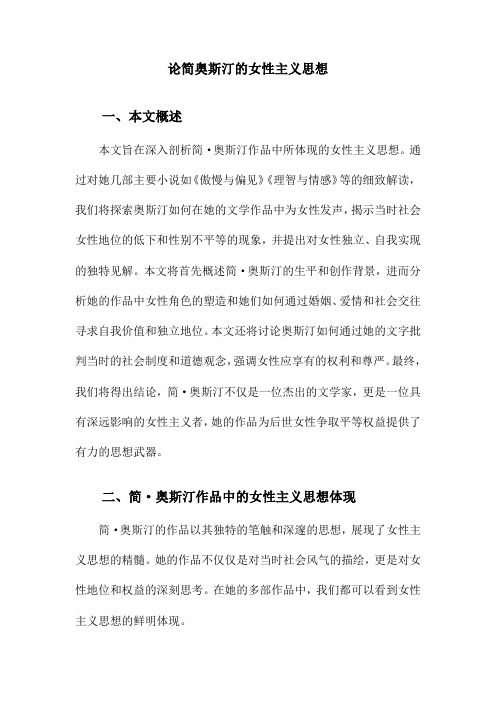
论简奥斯汀的女性主义思想一、本文概述本文旨在深入剖析简·奥斯汀作品中所体现的女性主义思想。
通过对她几部主要小说如《傲慢与偏见》《理智与情感》等的细致解读,我们将探索奥斯汀如何在她的文学作品中为女性发声,揭示当时社会女性地位的低下和性别不平等的现象,并提出对女性独立、自我实现的独特见解。
本文将首先概述简·奥斯汀的生平和创作背景,进而分析她的作品中女性角色的塑造和她们如何通过婚姻、爱情和社会交往寻求自我价值和独立地位。
本文还将讨论奥斯汀如何通过她的文字批判当时的社会制度和道德观念,强调女性应享有的权利和尊严。
最终,我们将得出结论,简·奥斯汀不仅是一位杰出的文学家,更是一位具有深远影响的女性主义者,她的作品为后世女性争取平等权益提供了有力的思想武器。
二、简·奥斯汀作品中的女性主义思想体现简·奥斯汀的作品以其独特的笔触和深邃的思想,展现了女性主义思想的精髓。
她的作品不仅仅是对当时社会风气的描绘,更是对女性地位和权益的深刻思考。
在她的多部作品中,我们都可以看到女性主义思想的鲜明体现。
在她的作品中,女性角色往往具有独立思考和自主选择的能力。
这些女性不再是被动的接受者,而是积极的参与者。
她们不仅对自己的婚姻大事有着清醒的认识,更在日常生活中展现出坚韧和智慧。
例如,《傲慢与偏见》中的伊丽莎白·班内特,她拒绝了达西的初次求婚,因为她认为达西的傲慢态度是对她人格的不尊重。
这一举动体现了她坚持自我价值、追求平等婚姻的决心。
奥斯汀在作品中批判了当时社会对女性的刻板印象和性别歧视。
她通过塑造一系列生动的女性形象,展示了女性在社会中的多种可能性和价值。
这些女性不仅拥有美貌和才华,更有着坚定的意志和独立的个性。
她们以自己的行动和选择,挑战了当时社会对女性的传统定义和期待。
奥斯汀在作品中强调了女性之间的互助和支持。
她描绘了女性之间深厚的友谊和亲情,以及她们在面对困境时的团结和勇敢。
介绍简奥斯汀的英语作文
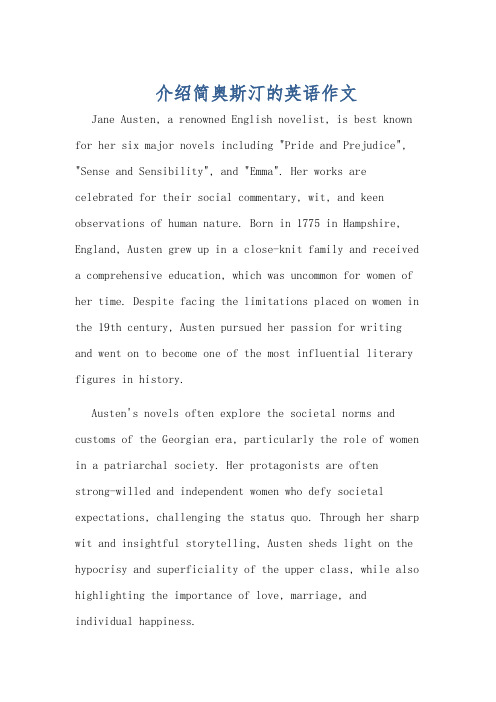
介绍简奥斯汀的英语作文Jane Austen, a renowned English novelist, is best known for her six major novels including "Pride and Prejudice", "Sense and Sensibility", and "Emma". Her works are celebrated for their social commentary, wit, and keen observations of human nature. Born in 1775 in Hampshire, England, Austen grew up in a close-knit family and received a comprehensive education, which was uncommon for women of her time. Despite facing the limitations placed on women in the 19th century, Austen pursued her passion for writing and went on to become one of the most influential literary figures in history.Austen's novels often explore the societal norms and customs of the Georgian era, particularly the role of women in a patriarchal society. Her protagonists are oftenstrong-willed and independent women who defy societal expectations, challenging the status quo. Through her sharp wit and insightful storytelling, Austen sheds light on the hypocrisy and superficiality of the upper class, while also highlighting the importance of love, marriage, and individual happiness.One of Austen's most beloved works, "Pride and Prejudice", is a timeless classic that continues to captivate readers around the world. The novel follows the tumultuous relationship between Elizabeth Bennet and Mr. Darcy, and is celebrated for its sharp social commentary, memorable characters, and enduring romance. Austen's keen understanding of human nature and her ability to craft compelling narratives have solidified her reputation as a literary genius.In addition to her literary achievements, Austen's personal life and experiences have also contributed to her enduring legacy. Though she never married, her letters and personal writings reveal a keen sense of humor and a deep understanding of human emotions. Her portrayal of love and relationships in her novels is often seen as a reflection of her own views and experiences, adding depth and authenticity to her work.In conclusion, Jane Austen's impact on literature and popular culture is immeasurable. Her timeless novels continue to inspire and entertain readers of all ages, and her legacy as a pioneering female author lives on. Throughher insightful social commentary and memorable characters, Austen's work remains as relevant and beloved today as it was during her lifetime.简·奥斯汀,一位著名的英国小说家,以她的六部主要小说《傲慢与偏见》、《理智与情感》和《艾玛》而闻名。
简奥斯汀文档

简奥斯汀简奥斯汀(Jane Austen)是英国著名的女性作家,被誉为英国文学史上最伟大的小说家之一。
她的作品以绘制出当时英国中产阶级社会生活的细腻描写而著称,以及对人性和婚姻问题的深刻洞察力。
奥斯汀的作品影响深远,被广泛研究和阅读,至今仍然具有重要的文化价值。
生平简介简奥斯汀于1775年12月16日出生在英国汉普郡的史蒂文顿(Steventon)。
她是一个拥有六个兄弟姐妹的家庭中的第七个孩子。
她的父亲是一位牧师,因此她的童年在宗教和文学氛围下度过。
尽管她的家庭并不富裕,但是家中的图书馆丰富多样,这让她从小就培养了对文学的兴趣。
奥斯汀在家庭教育下接受了良好的教育,她热爱阅读,并开始写作。
她的第一部小说《苦恼与自负》(Sense and Sensibility)于1811年匿名出版。
接下来的几年里,她相继出版了《傲慢与偏见》(Pride and Prejudice)和《爱玛》(Emma),这两部小说被认为是她的代表作品。
然而,尽管奥斯汀的作品备受好评,她的文学生涯并不如意。
由于当时女性在文学界的地位较低,奥斯汀并没有通过自己的作品取得经济上的成功。
而且,由于她对自己的作品进行匿名出版,直到她去世后,很少有人知道这些作品是她写的。
简奥斯汀于1817年7月18日逝世,享年41岁。
尽管她生前并没有得到足够的认可和赞赏,但在她逝世后的几十年里,她的作品逐渐被人们重新发现,并迅速赢得了读者们的喜爱。
她作品中对女性地位和婚姻问题的关注,以及对社会中产阶级生活的真实描绘,让她成为了英国文学史上一位伟大的女性作家。
主要作品简奥斯汀的作品主要关注女性的社会地位和婚姻问题,她的文字细腻入微,富有幽默感,令人捧腹。
她的作品融合了对社会习俗和人性的观察,展现了当时英国乡村中产阶级生活的方方面面。
以下是她的一些重要作品:1.《苦恼与自负》(Sense and Sensibility):这是奥斯汀的处女作,讲述了两个姐妹的故事,她们分别代表了理性和感性的两个极端。
简·奥斯汀
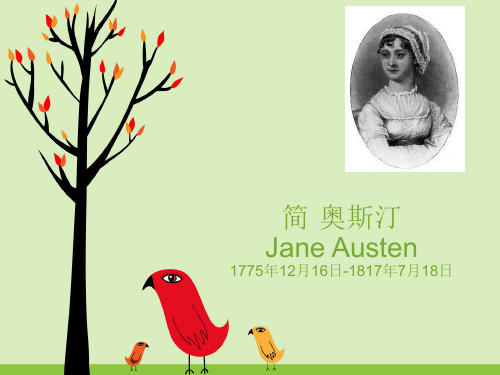
小说语言特点
奥斯丁的语言确实出色,这在提高她作品的水准上 起着很大的作用。
她的对话不但符合人物性格,而且常含机锋。不动 声色地说几句谑而不虐的反话,使读懂的读者不禁 要发出会心的微笑。(批评家瓦尔特·艾伦就说过, 整部《爱玛》,“就是在嘲弄中孕育成的。”)
叙述描写部分语言通常徐缓舒展,与她所写的那个 历史时期的社会环境与人物身份非常配称。
主要情节
埃莉诺和玛丽安是两姐妹,由于两姐妹的父亲逝世后遗 产归他前妻所生的儿子约翰,她们和她们的母亲不但经济上 拮据,还得摆脱寄人篱下的生活。她们终于在德文郡一座乡 间别墅内安了家。这一来,埃莉诺和她爱上的青年爱德华 (她嫂嫂范妮的弟弟)分了手,而玛丽安在乡间邂逅并迷恋 上的威洛比也突然有事去了伦敦。两姐妹就这样都和她们所 爱的人分开了。
《Pride and Prejudice》
出品时间:1995年
导演:Simon Langton 主演:科林·费斯,詹妮 弗·艾莉
《Mansfield Park》
出品时间:1999年
导演:帕特丽夏·罗兹玛 主演:阿梅丽娅·华纳, 约翰·李·米勒
主要情节
沃德家有三姐妹,一个有幸成了男爵夫人,一个很不幸 地嫁给了海军中尉,另外一个则不好也不坏地成为牧师的 妻子。幸运的老大在老三牧师太太的怂恿下,同意领养老 二的九个孩子中的一个。这样,年方十岁,羞怯而敏感的 范妮便住到曼斯菲尔德庄园来了。这个家里有四个表兄弟 姐妹汤姆、埃德蒙、玛丽亚和朱莉亚,只有埃德蒙是范妮 真正的朋友,其他人都让范妮饱尝寄人篱下之苦。
奈特利经常帮助哈丽特,这样使哈丽特对奈特利产生了 崇敬和爱慕的感情。当爱玛发现哈丽特崇拜的对象是奈特 利的时候,大吃一惊,原来她自己早已悄悄地爱上了奈特 利;奈特利常常指出爱玛的缺点,其实心底里也有意于她。 泰勒小姐生了一个女儿,这使爱玛开始向往家庭生活。经 过一番周折,奈特利和爱玛终于互吐衷情;罗伯特在奈特 利的帮助下,最后也得到了哈丽特的爱情。
简·奥斯丁和她的六部小说

著名的英国作家
英国作为一个老牌的欧洲国家, 英国作为一个老牌的欧洲国家,不计其数的优秀作家为 英国文学添了几分光彩。 英国文学添了几分光彩。 莎士比亚 狄更斯 拜伦、慈济、叶芝、 拜伦、慈济、叶芝、雪莱 柯南道尔 王尔德
评论家的话
“作家当中其手法最接近于(莎士比亚)这位大师的,无 作家当中其手法最接近于(莎士比亚)这位大师的, 疑就要数简奥斯丁了,这位女性堪称是英国之骄傲。她 疑就要数简奥斯丁了,这位女性堪称是英国之骄傲。 为我们创造出了一大批的人物……” 为我们创造出了一大批的人物……” 一百多年来,英国曾发生过几次趣味上的革命。 “一百多年来,英国曾发生过几次趣味上的革命。文学口 味的翻新影响了几乎所有作家的声望, 味的翻新影响了几乎所有作家的声望,唯独莎士比亚与 奥斯丁是经久不衰。 简奥斯丁是经久不衰。” “在所有的伟大的作家中,她的伟大之处是最最难以捕捉 在所有的伟大的作家中, 到的。 到的。
世界著名女作家
艾米丽勃朗特《呼啸山庄》 艾米丽 勃朗特《呼啸山庄》 勃朗特 深沉,优美, 深沉,优美,爱和恨的探索 乔治桑 魔沼》 乔治 桑《魔沼》: 另类, 另类,法国式的热情 玛格丽特米切尔 米切尔《 玛格丽特 米切尔《飘》 人物性格鲜明,令人欲罢不能 人物性格鲜明, 夏洛特勃朗特 勃朗特《 爱 夏洛特 勃朗特《简爱》 不做评论 J.K.罗琳“哈利波特”系列 罗琳“ ITY?
电影《理智与情感》 电影《理智与情感》 导演: 导演:李安 主演:凯特温丝莱特、 主演:凯特温丝莱特、休格兰 艾玛汤普森、阿伦 特、艾玛汤普森、阿伦瑞克曼 姐姐埃莉诺把爱深埋在心里, 姐姐埃莉诺把爱深埋在心里,妹妹 玛丽安从来不会半心半意的爱。 玛丽安从来不会半心半意的爱。 成长的标志之一 标志之一, 成长的标志之一,是用理智控制情 感。
简奥斯丁生平介绍
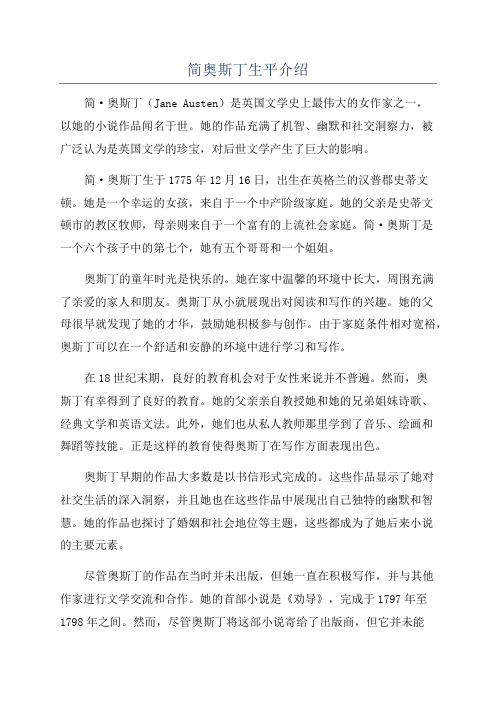
简奥斯丁生平介绍简·奥斯丁(Jane Austen)是英国文学史上最伟大的女作家之一,以她的小说作品闻名于世。
她的作品充满了机智、幽默和社交洞察力,被广泛认为是英国文学的珍宝,对后世文学产生了巨大的影响。
简·奥斯丁生于1775年12月16日,出生在英格兰的汉普郡史蒂文顿。
她是一个幸运的女孩,来自于一个中产阶级家庭。
她的父亲是史蒂文顿市的教区牧师,母亲则来自于一个富有的上流社会家庭。
简·奥斯丁是一个六个孩子中的第七个,她有五个哥哥和一个姐姐。
奥斯丁的童年时光是快乐的。
她在家中温馨的环境中长大,周围充满了亲爱的家人和朋友。
奥斯丁从小就展现出对阅读和写作的兴趣。
她的父母很早就发现了她的才华,鼓励她积极参与创作。
由于家庭条件相对宽裕,奥斯丁可以在一个舒适和安静的环境中进行学习和写作。
在18世纪末期,良好的教育机会对于女性来说并不普遍。
然而,奥斯丁有幸得到了良好的教育。
她的父亲亲自教授她和她的兄弟姐妹诗歌、经典文学和英语文法。
此外,她们也从私人教师那里学到了音乐、绘画和舞蹈等技能。
正是这样的教育使得奥斯丁在写作方面表现出色。
奥斯丁早期的作品大多数是以书信形式完成的。
这些作品显示了她对社交生活的深入洞察,并且她也在这些作品中展现出自己独特的幽默和智慧。
她的作品也探讨了婚姻和社会地位等主题,这些都成为了她后来小说的主要元素。
尽管奥斯丁的作品在当时并未出版,但她一直在积极写作,并与其他作家进行文学交流和合作。
她的首部小说是《劝导》,完成于1797年至1798年之间。
然而,尽管奥斯丁将这部小说寄给了出版商,但它并未能够被接受出版。
直到1809年,奥斯丁的第一部小说《傲慢与偏见》被出版,这部小说取得了巨大的商业成功。
奥斯丁在接下来的几年里继续创作,她写作了包括《理智与情感》、《曼斯菲尔德庄园》和《爱玛》在内的一些最重要的作品。
这些小说都具有她的特殊风格,包括对社会规范和婚姻制度的观察,以及对人性的深刻理解。
简·奥斯汀
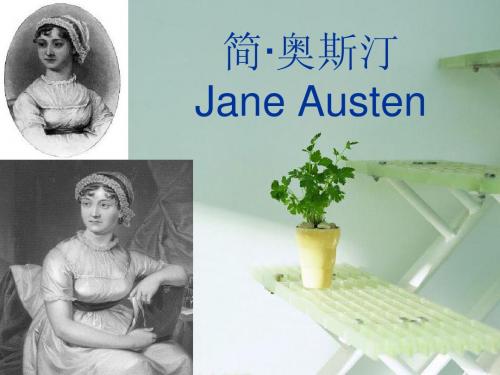
代表作品
《理智与情感》又名《理性与感性》(Sense and 理智与情感》又名《理性与感性》 Sensibility, 1811) 傲慢与偏见》 《傲慢与偏见》(Pride and Prejudice, 1813) 曼斯菲尔德庄园》 《曼斯菲尔德庄园》(Mansfield Park, 1814) 爱玛》 《爱玛》(Emma, 1815) 诺桑觉寺》 死后出版) 《诺桑觉寺》(Northanger Abbey, 1818, 死后出版 劝导》 死后出版) 《劝导》(Persuasion, 1818, 死后出版 据英国广播公司最近调查统计, 傲慢与偏见》 据英国广播公司最近调查统计,《傲慢与偏见》 在英国人最喜爱的小说中,名列第二。 爱玛》 在英国人最喜爱的小说中,名列第二。《爱玛》 (《Emma》)是这位女作家的第四部作品,一般 》 是这位女作家的第四部作品, 都认为是她最为成熟的一部作品
个人情感经历
1796年,20岁的奥斯汀遇到勒弗罗伊。情窦初 初恋以被迫分手告终,奥斯汀选择终身不嫁, 初恋以被迫分手告终,奥斯汀选择终身不嫁, 开的她对这个聪明狡黠的爱尔兰年轻律师一见钟情。 然而,奥斯汀的牧师家庭希望未来女婿拥有经济实 而将所有未了的情感注入文学创作。 爱的小屋” 而将所有未了的情感注入文学创作。“爱的小屋” 力,而偏偏那时的勒弗罗伊还是个穷小子。而拥有 身价飙升这段恋情没有让奥斯汀成为勒弗罗伊太 6个孩子的勒弗罗伊家也执意与富贵之家联姻,因 太,却激励她成为英国历史上最受欢迎的女作家 此要求勒弗罗伊返回爱尔兰。从此两人便再没有相 之一。 是他告诉她,她拥有才华。 之一。“是他告诉她,她拥有才华。是他鼓励她 见。当年,奥斯汀在致姐姐卡桑德拉的信中表达了 无奈伤心:“终于,这一天还是到来了,我将与汤 在写作中追随自己的思想。尽管他俩没有在一起, 在写作中追随自己的思想。尽管他俩没有在一起, 姆·勒弗罗伊告别。而当你收到这封信时,一切都已 但这段恋情却激发她成为职业作家。 雷说。 但这段恋情却激发她成为职业作家。”雷说。另 结束。一想到这些,我不禁泪流。”后来,勒弗罗 一方面, 一方面,奥斯汀和勒弗罗伊第一次相遇的房子也 伊如家人所愿地娶了个大家闺秀,还成为爱尔兰最 行情看涨。这座名为“迪恩小屋” 行情看涨。这座名为“迪恩小屋”的房子坐落在 高法院首席法官。直至晚年,他才向侄子坦言,曾 与一位作家有过一段“少年之爱”。 汉普郡,充满浓郁的英式特点,典雅而舒适。 汉普郡,充满浓郁的英式特点,典雅而舒适。悠 久历史、建筑价值再加上凄美爱情故事, 久历史、建筑价值再加上凄美爱情故事,这座小 屋已经被开出1000万英镑的高价。 万英镑的高价。 屋已经被开出 万英镑的高价
(完整word版)简奥斯丁生平介绍

几百年来,欧洲文坛涌现了一大批才华横溢的女作家,他们以女性特有的眼光观察分析世界。
真实反映各个社会时期人民的情怀遭遇命运;女性小说已成为欧美文学的重要组成部分,它记载了作为主流文学的男性文本说无法反映的女性经验和意识,引起了女性读者的认同感和男性读者的深刻反思。
像所有的经典小说一样,女性小说充分体现了艺术性和创作性,像《傲慢与偏见》《飘》这类的经典力作使很多男性作家都自叹弗如,而且在亿万读者中享有盛誉。
我们将选取几位代表性的作家,感悟他们不凡的人生,品读流芳百世的佳作,领略女作家的风采。
第一章简奥斯丁一简·奥斯汀的时代有句话说“时势造英雄”,这句话用在奥斯汀身上也不无道理,特定的时代造就特定的社会,也造就这个社会中人们的思想。
简.奥斯汀生活在18世纪后期到19世纪前期的英国,这个时期在欧洲和英国发生了一系列包括政治和经济的巨大变化,影响了人们的生活和思想.正是在这样的背景下,产生和造就了这样一位特殊的女作家和她的思想。
因此,了解这一时期英国的社会情况,是研究简·奥斯汀思想的社会源流的切入点。
1 8世纪后期到19世纪前期的这段历史,由三个大的主要事件贯穿起来:启蒙运动、法国大革命和拿破仑战争。
这些事件相互关联,相互激荡,不仅影响和改变了法国的面貌,而且通过文化的、政治的方式冲击英国,从而使英国社会在政治、思想、社会生活等方面产生了一些变化。
在启蒙运动中,哲学家们对女性角色和女性美德也进行了论述。
启蒙运动中的哲学家们提倡妇女应当受教育。
这些思想对当时妇女运动和普通妇女的生活产生了一定的影响,使得她们在遵守这些传统规范的同时,行为和思想也因为社会变迁而有所变化。
在简·奥斯汀的作品里面,妇女的教育问题也是她关心的一个重要的方面,她作品中的女子几乎都接受了传统社会下的妇女教育观念,但在传统的基础上也有新的变化。
这些变化的来源主要是紧跟着启蒙运动发生的法国大革命和拿破仑战争。
这两个相关的事件首先影响了欧洲国家的政治,政治上的影响进一步带来民众生活方式和思想的变化。
浅析《傲慢与偏见》中简奥斯汀的婚姻观

二、心灵之爱的婚姻
达西夫妇的婚姻是另一种类型的理想婚姻。他们的爱情是心灵之爱,这种爱 情是建立在互相理解、尊重和欣赏的基础上的。达西对伊丽莎白的爱不是一见钟 情,而是通过长时间的相处和交流逐渐产生的。他们的婚姻没有一见钟情的浪漫, 但是有着深厚的感情基础和相互支持。这种婚姻需要夫妻之间建立良好的沟通和 信任机制,才能保持稳定和幸福。
总的来说,《傲慢与偏见》是一部深入探讨婚姻、爱情和社会阶层的作品。 通过细腻的人物描绘和情节设计,奥斯汀向我们展示了她的婚姻观:她强调了感 情在婚姻中的重要性,揭示了社会阶层对婚姻的影响,同时也揭示了当时社会中 存在的婚姻观念的局限性。这部小说以其深刻的思想和情感,优美的语言和细腻 的描写,成为了世界文学史上的珍品。
在《傲慢与偏见》中,达西先生与其他人的关系充满了误解和冲突。然而, 正是这些误解和冲突,推动了他的性格发展和情感成长。在与伊丽莎白·班内特 的交往中,达西的傲慢和偏见让他误解了班内特一家的行为和态度。然而,随着 故事的深入,达西逐渐通过自我反思和行动,克服了他的傲慢与偏见,最终赢得 了伊丽莎白的爱情。
同时,简奥斯汀也通过达西的求婚过程,强调了婚姻中互相尊重和理解的重 要性。达西虽然出身高贵,但他的傲慢和自大使伊丽莎白对他产生了厌恶之情。 然而,在达西改变自己,学会尊重和理解伊丽莎白后,伊丽莎白最终答应了他的 求婚。这表明了简奥斯汀认为,婚姻中的伴侣应该尊重彼此的差异,并通过理解 和接纳这些差异来建立稳定和幸福的婚姻关系。
奥斯汀在《傲慢与偏见》中呈现的婚姻观,强调了理解、尊重和品行的重要 性。她认为,婚姻不应该仅仅是基于和品行的选择。这一点在达西的性格发展中得到了充分的体现。达西虽然在 开始时表现出了傲慢和偏见,但他最终能够克服这些缺点,以真实的自我赢得伊 丽莎白的爱情。这说明,奥斯汀认为,婚姻的选择应该是基于一个人内在的品质 和性格,而不是外在的地位和财富。
- 1、下载文档前请自行甄别文档内容的完整性,平台不提供额外的编辑、内容补充、找答案等附加服务。
- 2、"仅部分预览"的文档,不可在线预览部分如存在完整性等问题,可反馈申请退款(可完整预览的文档不适用该条件!)。
- 3、如文档侵犯您的权益,请联系客服反馈,我们会尽快为您处理(人工客服工作时间:9:00-18:30)。
简·奥斯汀(英语:Jane Austen,1775年12月16日-1817年7月18日),19世纪英国小说家,世界文学史上最具影响力的女性文学家之一,其最著名的作品是《傲慢与偏见》和《理智与情感》,以细致入微的观察和活泼风趣的文字著称。
Jane Austen (16 December 1775 – 18 July 1817) was an English novelist whose works of romantic fiction, set among the landed gentry, earned her a place as one of the most widely read writers in English literature. Her realism, biting irony and social commentary have gained her historical importance among scholars and critics.[1]Austen lived her entire life as part of a close-knit family located on the lower fringes of the English landed gentry.[2]She was educated primarily by her father and older brothers as well as through her own reading. The steadfast support of her family was critical to her development as a professional writer.[3]Her artistic apprenticeship lasted from her teenage years into her thirties. During this period, she experimented with various literary forms, including the epistolary novel which she then abandoned, and wrote and extensively revised three major novels and began a fourth.[B] From 1811 until 1816, with the release of Sense and Sensibility(1811), Pride and Prejudice(1813), Mansfield Park (1814) and Emma (1816), she achieved success as a published writer. She wrote two additional novels, Northanger Abbey and Persuasion, both published posthumously in 1818, and began a third, which was eventually titled Sanditon, but died before completing it.Austen's works critique the novels of sensibility of the second half of the 18th century and are part of the transition to 19th-century realism.[4][C] Her plots, though fundamentally comic,[5]highlight the dependence of women on marriage to secure social standing and economic security.[6] Her work brought her little personal fame and only a few positive reviews during her lifetime, but the publication in 1869 of her nephew's A Memoir of Jane Austen introduced her to a wider public, and by the 1940s she had become widely accepted in academia as a great English writer. The second half of the 20th century saw a proliferation of Austen scholarship and the emergence of a Janeite fan culture.of Jane AustenBiographical information concerning Jane Austen is "famously scarce", according to one biographer.[7] Only some personal and family letters remain (by one estimate only 160 out of Austen's 3,000 letters are extant),[8] and her sister Cassandra (to whom most of the letters were originally addressed) burned "the greater part" of the ones she kept andcensored those she did not destroy.[9]Other letters were destroyed by the heirs of Admiral Francis Austen, Jane's brother.[10]Most of the biographical material produced for fifty years after Austen's death was written by her relatives and reflects the family's biases in favour of "good quiet Aunt Jane". Scholars have unearthed little information since.[7]简有六个哥哥和一个姐姐Cassandra,其中两个兄长后来也从事神职,另两名则曾供职英国海军。
姐姐Cassandra是珍最亲近的人,姐妹间的信件为后人的研究提供了很多素材,其所作的简画像目前保存在伦敦的国家肖像馆内。
Early life and educationSteventon rectory, as depicted in A Memoir of Jane Austen, was in a valley and surrounded by meadows.[21]Austen was born on 16 December 1775 at Steventon rectory and publicly christened on 5 April 1776.[22]After a few months at home, her mother placed Austen with Elizabeth Littlewood, a woman living nearby, who nursed and raised Austen for a year or eighteen months.[23]In 1783, according to family tradition, Jane and Cassandra were sent to Oxford to be educated by Mrs. Ann Cawley and they moved with her to Southampton later in the year. Both girls caught typhus and Jane nearly died.[24]Austen was subsequently educated at home, until leaving for boarding school with her sister Cassandra early in 1785. The school curriculum probably included some French, spelling, needlework, dancing and music and, perhaps, drama. By December 1786, Jane and Cassandra had returned home because the Austens could not afford to send both of their daughters to school.[25]Austen acquired the remainder of her education by reading books, guided by her father and her brothers James and Henry.[26]George Austen apparently gave his daughters unfettered access to his large and varied library, was tolerant of Austen's sometimes risqué experiments in writing, and provided both sisters with expensive paper and other materials for their writing and drawing.[27] According to Park Honan, a biographer of Austen, life in the Austen home was lived in "an open, amused, easy intellectual atmosphere" where the ideas of those with whom the Austens might disagree politically or socially were considered and discussed.[28]After returningfrom school in 1786, Austen "never again lived anywhere beyond the bounds of her immediate family environment".[29]Private theatricals were also a part of Austen's education. From when she was seven until she was thirteen, the family and close friends staged a series of plays, including Richard Sheridan's The Rivals(1775) and David Garrick's Bon Ton. While the details are unknown, Austen would certainly have joined in these activities, as a spectator at first and as a participant when she was older.[30]Most of the plays were comedies, which suggests one way in which Austen's comedic and satirical gifts were cultivated.[31]In 1788, her portrait may have been commissioned by her great uncle, Francis Austen.长篇小说•《理智与情感》(英语:Sense and Sensibility,1811年出版)•《傲慢与偏见》(英语:Pride and Prejudice,1813年出版)•《曼斯菲尔德庄园》(英语:Mansfield Park,1814年出版)•《爱玛》(英语:Emma,1815年)•《诺桑觉寺》(英语:Northanger Abbey,1818年,死后出版)•《劝导》(英语:Persuasion,1818年,死后出版)短篇小说•《苏珊夫人》(英语:Lady Susan)未完成的作品•《沃森一家》(英语:The Watsons)•《桑迪顿》(英语:Sanditon)其他作品•Sir Charles Grandison•Plan of a NovelJane Austen (1775-1817)◆A English writer, who firstgave the novel its moderncharacter, through thetreatment of everyday life.◆Jane Austen was born in Steventon, Hampshire, where her father was a rector. She was the second daughter and seventh child in a family of eight. The first 25 years of her life,Austen spent in Hampshire. She was tutored at home. Her parents were avid readers and she received a broader education than many women of her time. On her father‘s retirement, the family moved to Bath.. Austen focused on middle-class provincial life with humor and understanding. She depicted the life of minor landed gentry, country clergymen and their families, in which marriage mainly determined women's social status.◆Most important for her were those little matters, as Emma says, "on which the daily happiness of private life depends."◆Although Austen restricted to family matters, and she passed the historical events of the Napoleonic wars, her wit and observant narrative touch has been inexhaustible delight to readers.◆Of her six great novels, four were published anonymously during her lifetime.◆At her death on July 18, 1817 in Winchester, Austen was writing the unfinished Sanditon. Austen was buried in Winchester Cathedral.奥斯汀终身未婚,家道小康。
